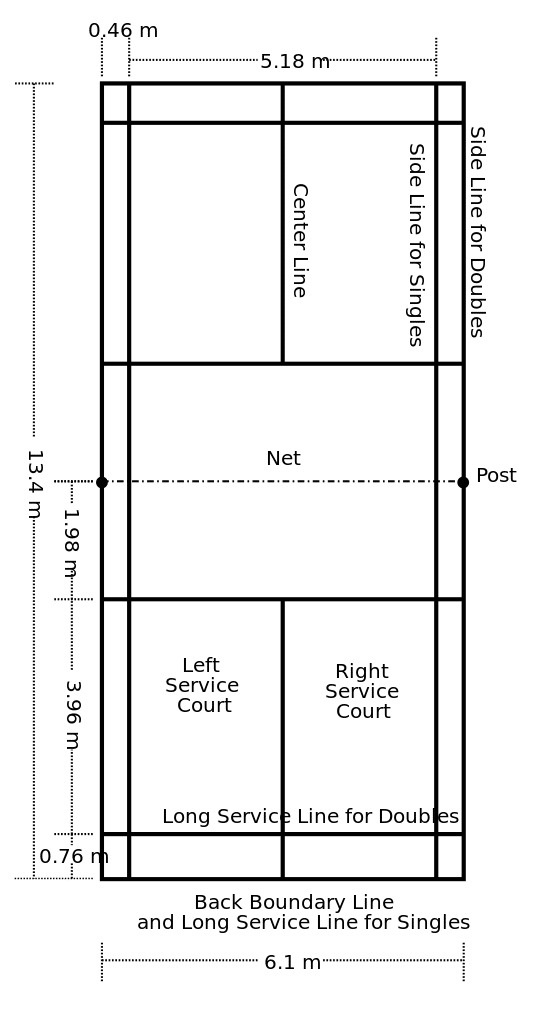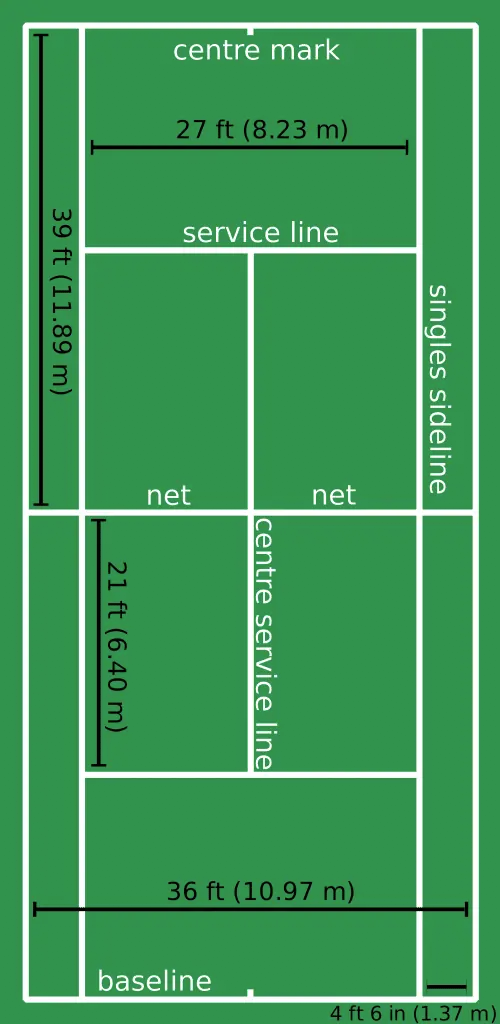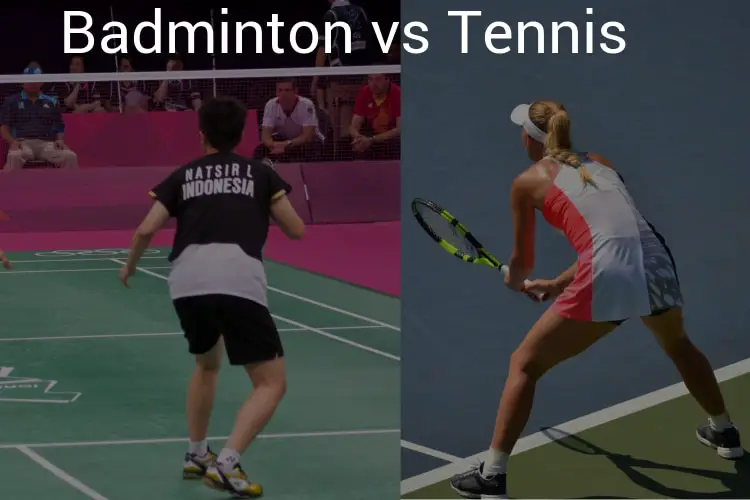Which matches last longer, badminton matches or tennis matches? Which sport burns more calories per hour played, badminton or tennis? What is the difference in court measurements between badminton and tennis? Which sport is more practiced, badminton or tennis?
If you have ever asked yourself (or Google) any of these questions or any other one that compares badminton vs tennis, you are in the right place. In this post, we are going to compare everything that can be compared between badminton and tennis. Curious? Then read on!
Do you want to improve your badminton game? Then be sure to sign up for Badminton Famly+ by clicking here. Founded by former World Champion Thomas Laybourn, Badminton Famly+ is the best online training platform for badminton.
Duration – Badminton vs Tennis
Time is one of the most important things in life and also a common question when comparing badminton and tennis. However, time can be measured in a lot of different ways and so is the case in sports. In this section, we will talk about the average duration of a rally, the average duration of a set and the
Average duration of a rally
| Average duration of a rally for male players | Average duration of rally for female players |
||
|---|---|---|---|
| Badminton | Tennis | Badminton | Tennis |
| 4.62 seconds | 5.8 seconds | 4.16 seconds | 6.3 seconds |
Rallies are, on average, shorter in badminton than in tennis. Even though the statistics vary in tennis due to the different surfaces and conditions it is played on, the trend is the same in all of them. The duration of the average rally is shorter in badminton. How much shorter though? According to a study done by the University of Malaysia, the average rally of their tested matches was 4.62 seconds for male players and 4.16 seconds for female players.
Regarding tennis, according to a study done by the University of Sydney, the range goes from 5.2 seconds for male players in Wimbledon, to 7.0 seconds for female players in the Australia Open. This means that the average duration of a point for tennis is between 1.1 and 1.7 times that of badminton. Although we haven’t found any study, we assume that the difference would be even bigger if we compared badminton to Roland-Garros.
This is certainly not the average of a tennis rally
Average duration of a match
Also, matches are, on average, shorter in badminton than in tennis. According to the data available from the University of Malaysia, the average duration of a badminton match is a bit more than 17 minutes. This is a bit different from a study undertaken by the University of Granada, which increases the average match duration to a bit more than 28 minutes.
This figure is, in any case, very far from that of tennis matches. Taking the same study from the University of Sydney, the average match duration went from 65 minutes (1 hour and 5 minutes) for females in Wimbledon, to 154 minutes (2 hours and 34 minutes) for males in the Australia Open. This means that the average duration of a match for tennis is between 2.3 and 5.5 times that of badminton.
If you are currently playing tennis and are thinking about giving badminton a try, you can check our badminton match post where you will find all the information required to start a badminton match.
Average duration of effective playing time in a match
The surprise comes now. Even though badminton matches are, in principle, much shorter than tennis matches, the difference in effective playing time is not as high.
According to the study from the University of Granada, the average effective playing time was a bit more than 9 minutes for badminton.
As for tennis, the average effective playing time went from 13 minutes for females in Wimbledon, to 26 minutes for males in the Australia Open. This means that the average effective playing time for tennis is between 1.4 and 2.9 times that of badminton.
Speed – Badminton vs Tennis
Time and speed are interlocked in life and also in the badminton vs tennis post. Even though we could measure the speed of a lot of items, there is one element that dwarfs all others in importance, and that is the speed of the ball or shuttle.
Speed of ball/shuttle
| Badminton | Tennis |
|---|---|
| 426 km/h (264.7 mph) | 263 km/h (163.4 mph) |
This is a very common question with an answer that might surprise you. Somehow, we think that, because tennis courts are bigger and the rackets heavier and balls heavier, that the speed of the ball will also be higher. However, this is far from true.
According to the Guinness World Record, the fastest ever shot in tennis is 263 km/h (163.4 mph). On the other hand, according to the same source, the fastest ever shot in badminton was 426 km/h (264.7 mph). This means that the fastest ever shot in badminton is 1.6 times faster than the one in tennis.
As for females, according to the Guinness World Record, the fastest ever shot in tennis is 131 km/h (81.4 mph). On the other hand, according to Badminton Planet, the fastest ever shot in badminton is 372 km/h (231.1 mph). This means that the fastest ever shot in female badminton is 2.8 times faster than the one in tennis.
Weight – Badminton vs tennis
People always worry about time and speed, but they do also worry about weight. As for badminton and tennis, the weight of the different tools used while playing the game is an interesting comparison.
Weight of rackets
| Badminton | Tennis |
|---|---|
| 2.8 - 3.5 ounces (80 grams – 100 grams) | 9 - 12 ounces (255 - 340 grams) |
Rackets are one of the most important items in a tennis match and in a badminton match, as they are the tool that the players use in order to hit the ball or the shuttle. They are so important that their requirements are heavily regulated. If you want to see all the requirements that the rackets need to fulfill in order to be accepted for play, have a look at our badminton measurements post.
As for tennis, the weight of the rackets usually varies between 9 and 12 ounces (255 and 340 grams). For example, Rafael Nadal’s racket weights 11.2oz / 318g, whereas Novak Djokovic’s racket weights 11.5oz / 326g.
As far as badminton is concerned, the weight of the rackets usually varies between 2.8 and 3.5 ounces (80 grams – 100 grams). This means that a tennis racket is between 2.5 and 4 times heavier than a badminton racket.
Weight of shuttle/ball
| Badminton | Tennis |
|---|---|
| 4.75 - 5.50 g (0.168 -0.194 oz | 56.0–59.4 g (1.98–2.10 ounces) |
The shuttlecock and the tennis ball are the projectiles that the players have to hit with the aim of making a shot that the other player cannot return. Even though they are both the central part of the sport, they could not be more different between themselves
As for the weight? Well, shuttlecocks for a competition can weigh between 4.75 to 5.50 g (0.168 to 0.194 oz), whereas tennis balls can weigh between 56.0–59.4 g (1.98–2.10 ounces), which means that tennis balls are between 10 and 12 times heavier than badminton shuttles. Quite a difference!
Dimensions – Badminton vs Tennis
Weight is not the only measurement that matters. Other interesting comparisons between badminton and tennis are regarding dimensions such as length or width.
Court dimensions
Badminton and tennis courts are quite different. Whereas badminton is always played indoors (professionally) and usually with a mat made of a durable PVC material, tennis can be played both indoors and outdoors and the material of the surface is played on change from clay to grass to acrylic. If you want to know more about the badminton court, specifically the badminton court used in tournaments, you can check our badminton mats post, where we explain, between other things, how a mat compares to the other materials where you can play badminton.

However, the difference is also present in the sizes. Whereas the tennis court is 78 feet long and 36 feet wide (23.78 x 10.97 meters), the badminton court is 44 feet long by 17 feet wide (13.4 x 5.18 meters). This means that a tennis court is 1.8 times longer and 2.1 times wider.

Racket dimensions
As we said before, rackets are heavily regulated, especially when it comes to dimensions. As for tennis, the ITF has the following restrictions:
- Maximum total length: 29.0 inches (73.7 cm)
- Maximum total width: 12.5 inches (31.7 cm)
- Maximum hitting surface length: 15.5 inches (39.4 cm)
- Maximum hitting surface width: 11.5 inches (29.2 cm)
As for badminton, the BWF has the following restrictions:
- Maximum total length: 26.8 inches (68 cm)
- Maximum total width: 9.1 inches (23 cm)
- Maximum hitting surface length: 11 inches (28 cm)
- Maximum hitting surface width: 8.7 inches (22 cm)
Ball/Shuttle dimensions
As far as the projectiles are concerned, the difference in size is quite significant, but mainly due to the different shape, which makes it difficult to compare.
For badminton, an extract is taken from our badminton measurements post:
The shuttle shall have 16 feathers fixed in the base. The feathers shall have a uniform length between 62 mm (2.5
inch ) to 70 mm (2.75inch ) when measured from the tip to the top of the base.
Th e tips of the feathers shall lie on a circle with a diameter from 58 mm (2.3inch ) to 68 mm (2.7inch ).
Th e feathers shall be fastened firmly with thread or other suitable material.The base shall be 25 mm (1 inch) to 28 mm (1.1
Extract from our badminton measurements postinch ) in diameter and rounded on the bottom.
As for tennis, the ball measurements are defined by the International Tennis Federation (ITF), with an official diameter of 2.57-2.7 inches (6-54-6.86 cm).
Shots – Badminton vs Tennis
Having already spoken about matches duration, it is also interesting to see the average number of shots per point played. Taking into account the same studies as for the duration, the average number of shots per point in badminton ranges from 4.74 from the University of Malasia to 6.06 from the University of Granada.
As far as tennis is concerned, according to the University of Sydney, the average would go between 3.9 for male players in Wimbledon to 4.9 for female players in the Australia Open (if you wonder how this has been calculated, I just divided the stroke frequency (strokes per minute) by the average point duration to get the average stroke per point.
This means that the average point in badminton, even though is slower (tennis points last between 1.1 and 1.7 times longer), has more strokes. To be specific, around 1.2 times more strokes in fewer time, which highlights that the speed of the game is faster in badminton than it is in tennis.
Practitioners – Badminton vs Tennis
Until now we have compared everything related to the game itself. Now we are changing gears a little bit and we are going to compare a few statistics a bit more related to human beings. The first comparison is the number of people that actually practice the two different sports. This one will be a rather surprising one if you are not familiar with it.
According to Pledge Sports, both sports are within the top 10 most popular sports in the world by participation. Are you surprised by that? Did not expect badminton to be there?
Well, badminton is a very important sport in both India and China and, those two being the two most populated countries in the world, they help badminton be present in this ranking.
The fact that tennis is present should not come as such a big surprise if you are from an English speaking country, as tennis is really important in most developed countries.
Tennis, always according to Pledge Sports, who in turn cites Topend Sports, is played by 60 million people worldwide. Badminton, on the other hand, would be played by around 220 million people worldwide.
According to ESPN, badminton would be the second most popular sport in the world, only after soccer.
However, it is worth noting that we haven’t found any fully reliable data, so the information from this section should be taken only as a point of reference and is not as statistically relevant as the previous data.
Earnings – Badminton vs Tennis
Whereas badminton is the winner in participation, things don’t look so bright in player’s earnings. Here, probably due to the fact that tennis is more followed in richer countries, tennis gets the upper hand as far as earnings are concerned.
In tennis, according to successstory.com, the top 5 richest players go as follows:
- Roger Federer – $300 million
- Andre Agassi – $175 Million
- Pete Sampras – $150 Million
- Serena Williams – $120 Million
- Rafael Nadal – $100 Million
In badminton, according to successstory.com, the top 5 richest players go as follows:
- Lee Chong Wei – $35 Million
- Lin Dan – $26 Million
- Saina Nehwal – $24 Million
- Peter Gade – $18 Million
- Taufik Hidayat – $11 Million
As you can see, the difference is quite big. The richest tennis player (Roger Federer) is 8.5 times richer than the richest badminton player (Lee Chong Wei). A similar proportion holds for the 5th richest player, Rafael Nadal
Calories burned – Badminton vs Tennis
Our final section compares the calories burned in both sports. In a lot of posts online, badminton is said to be a much tougher sport than tennis when comparing both sports.
However, this is contrary to the evidence we have found in reliable studies. As much as we would like to give badminton the winning side, evidence demonstrates the opposite. According to Captain Calculator, tennis has a MET (Metabolic Equivalent Task) of 8 when playing singles, whereas, also according to Captian Calculator, badminton has a MET of 7 when playing at a competitive level. What is a MET though?
What is Metabolic Equivalent of Task (MET)?
A metabolic equivalent (MET) value is a measurement of the energy cost of a specific physical activity for a specific period of time.A MET of 1 would be roughly equivalent to a person’s energy expenditure from sitting still in a temperature neutral (room temperature) room and not actively digesting food.
Extract from Captian Calculator
So, according to this data (which has been taken from the Compendium of Physical Activities), tennis burns more calories per minute exercised than badminton does. If you are curious as to how much you would burn in a certain period of time, you can follow the two links below
We did a quick example for a person weighting 80 kilos and playing for one hour and the results are as follows:
Calories burned in tennis for a person weighing 80 kilos and playing for 1 hour
| Type of Activity | MET | Calories Burned |
|---|---|---|
| Doubles | 6 | 504 |
| General | 7.3 | 613 |
| Singles | 8 | 672 |
Calories burned in badminton for a person weighing 80 kilos and playing for 1 hour
| Type of Activity | MET | Calories Burned |
|---|---|---|
| Badminton, social singles and doubles, general | 5.5 | 462 |
| Badminton, competitive | 7 | 588 |
Want to bring your badminton to the next level? Check Badminton Famly+
If you want to improve your game, you can sign up for the Badminton Famly+ program following this affiliate link. By following this link, you will receive 30% off the first month.
This e-learning platform is co-created by Thomas Laybourn, Danish player, former World number 1, World Champion, and professional coach.
They are doing an awesome job with their online training and they have an incredible amount of information on how to improve your game.
With such trustworthy founders, it is no surprise that this is, by far, the best online training program I have been able to find.
Final words
And with this last comparison, we have arrived at the end of the post. Is there any comparison that you have not found and that you would like to see? Do you have any other comments on the post? Then let me know in the comments below!


hello its post very interesting
I’m no longer certain where you are getting your information, however good
topic. I must spend some time learning more or working out more.
Thanks for great information I was on the lookout for this info for my mission.
Spot on with this write-up, I absolutely believe that this
site needs far more attention. I’ll probably be back again to
see more, thanks for the advice!
Hello, I enjoy reading through your post. I like to write
a little comment to support you.
Very nice post. I absolutely appreciate this site. Thanks!
It’s interesting to know that badminton games are officially played only indoors while tennis can be played either way. I’m thinking about hiring a tennis construction contractor soon in order to be able to play sports at home and keep myself fit. I guess I will just stick to playing tennis since I prefer playing sports outdoors since it feels less stuffy.